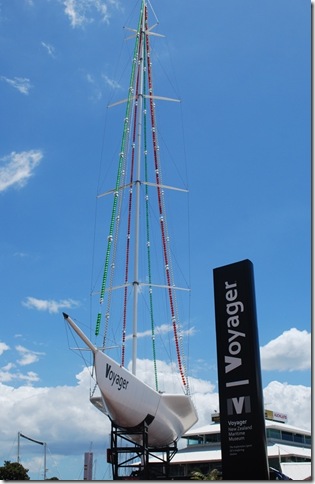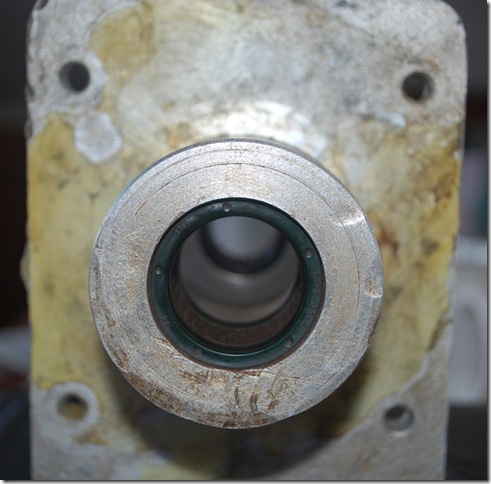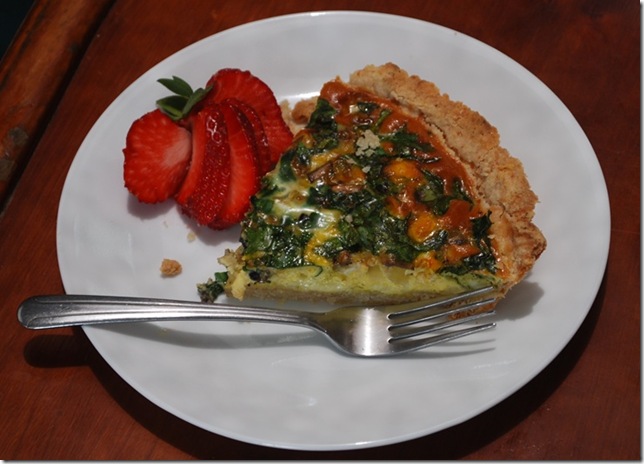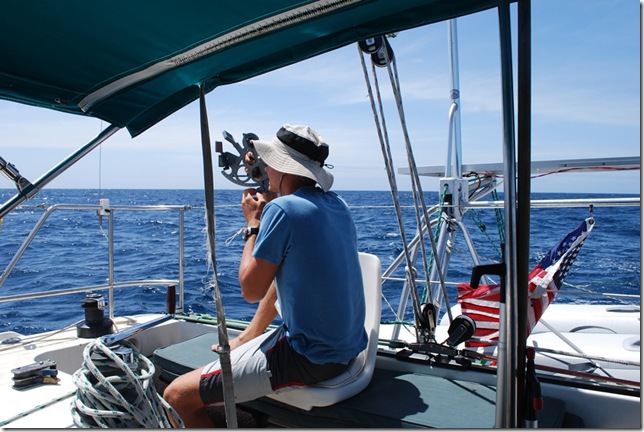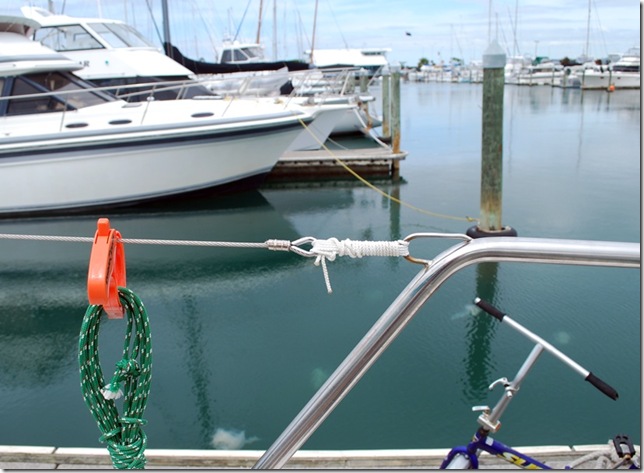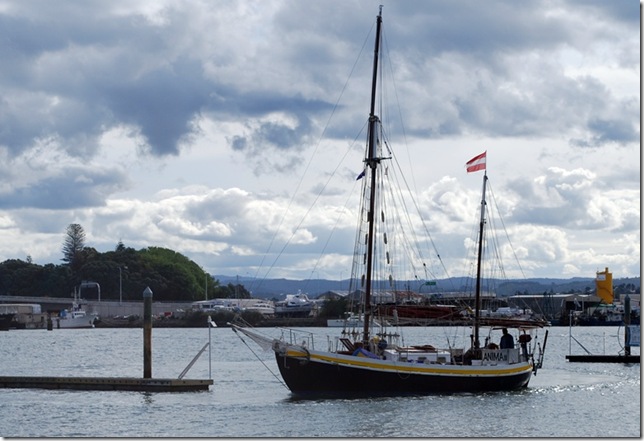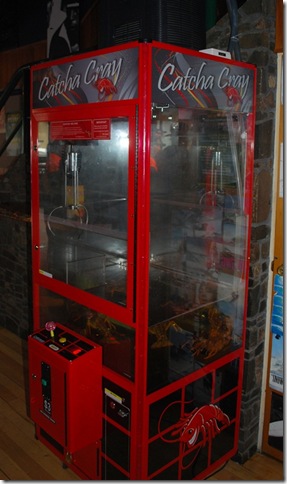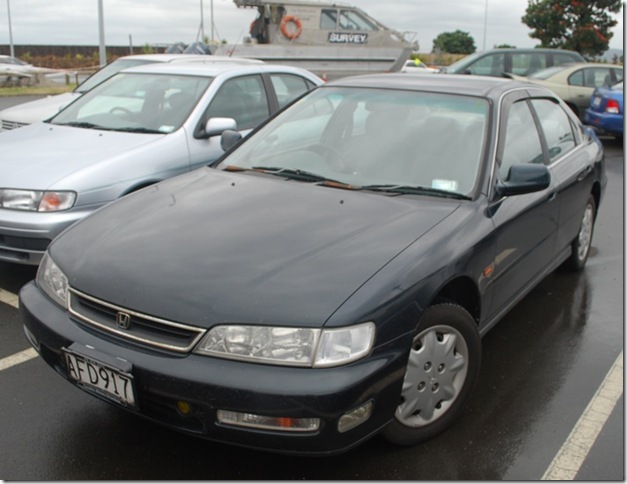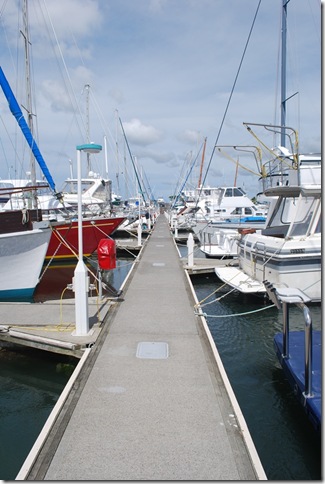Christmas in summer certainly is a unique experience. The holiday itself is celebrated much like in the U.S. in the sense that it is a time to enjoy family, give to others, go to church, and of course, eat as much as you possibly can, but some things are inevitably different than in the northern hemisphere as a result of the summer climate. Instead of a White Christmas, Kiwis might hope for “sweet as” conditions for surfing and boating. Rather than roasting a ham and drinking egg nog, they opt to throw some steaks and shish kebobs on the “barbie” and drink some nice, cold Tui or Steinlager beer. Apparently the Kiwi kids still believe that Santa delivers presents on his flying sleigh, but it’s hard to imagine that he would wear a furry, red suit when the temperature is approaching 80 degrees!
Dallas and I had a Merry Kiwi Christmas with the help of our friend Mel and her family in the Auckland area. They welcomed us as their guests and treated us to an awesome meal. We were able to eat outside on their veranda thanks to the shade of the umbrella. Our hosts agreed that the sun is particularly blazing here, more so than in nearby Australia. Young children are required to wear hats here when playing outdoors at school.
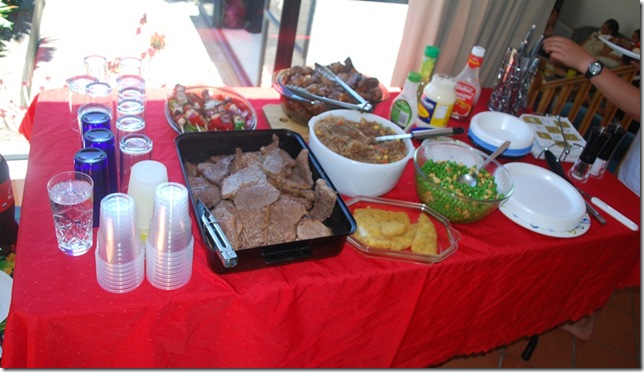 One of two food tables at the summer Christmas lunch
One of two food tables at the summer Christmas lunch
We talked more with Mel about the mix of cultures that are prevalent within NZ. She indicated that while Kiwis are totally Westernized, a minority still participate fully in Maori traditions such as meeting at the maraes and speaking the Maori language. Many other modern Maori are raised as though they were “pakeha” (descended from white Europeans). However, it seems that traditional Maori funerals have stood the test of time and European influence among many families of Maori heritage. In Mel’s family and presumably many others, it is customary for the deceased person to be brought back to his/her home for three days, during which time the immediate and extended family members sleep in the same room and say their good-byes.
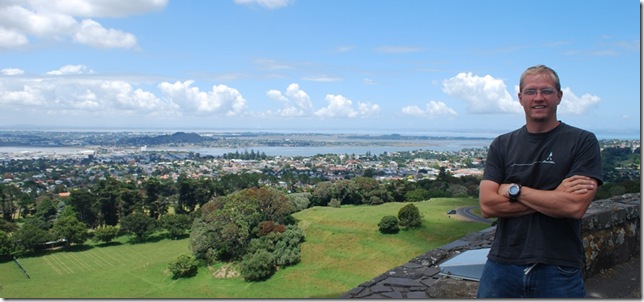 A beautiful day at Cornwall Park in Auckland
A beautiful day at Cornwall Park in Auckland Sheared sheep mowing the park’s grass
Sheared sheep mowing the park’s grass
Also while in Auckland, we spent an afternoon in the New Zealand National Maritime Museum. Unlike Maori traditions, the culture of the sea has always been well represented in these islands, from the early Polynesian navigators who found their way here using the stars, to the European explorers/whalers that eventually immigrated, to the present day fishing charters and sailing regattas that have become national past times. The exhibits displayed each of these eras and included full-size replicas of ancient Polynesian canoes as well as smaller replicas of the last of the tall ships (masts reaching over 150′!) to be sailed around the dreaded Cape Horn as part of the Australian grain trade. The video footage of the hurricane winds encountered by such a ship in the late 1940’s as well as the crew’s configuration along the yards of the mast (horizontal spars far above deck) to set/stow the sails, helped to tell their tales of adventure.
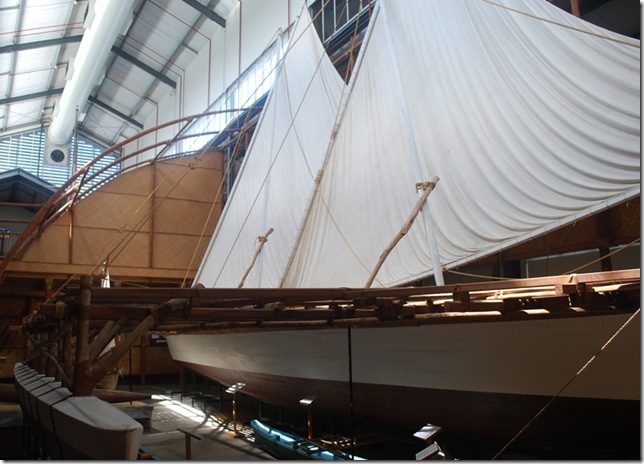 The outrigger of the canoe belongs on the windward side
The outrigger of the canoe belongs on the windward side
This Kiwi “Big Boat” was no match for the American’s catamaran in the controversial America’s Cup of 1988
There also was a special exhibit to honor the deceased Sir Peter Blake, a national hero. Peter’s crews won multiple round-the-world races, including a non-stop, 74-day voyage aboard Enza, a catamaran that averaged 16 knots! Video footage of Enza’s journey depicted crewmembers dodging icebergs in the high latitudes (60’s) and trying to hang on to the stern in 70-knot winds while deploying a drogue. In addition to these amazing feats, Peter also led an NZ crew to victory in the 1995 and 2000 America’s Cup regattas and led expeditions to Antarctica and the Amazon. He later founded an organization dedicated to environmental preservation in the Amazon, where he was ultimately killed from behind by thieves after going below deck to retrieve his gun. A pretty eventful life, I would say.
Our lives are not nearly so eventful at the moment, but we are looking forward to having some Kiwi-style adventures following my parents’ arrival in early January. They have planned an ambitious itinerary of exploration, particularly around the South Island. It should be an unforgettable trip that we will be sure to share with you.
In the meantime, I am pleased to share that Dallas penned a feature article for the January issue of SAIL magazine, which is now in newsstands! It is SAIL’s annual multihull edition, and Dallas’ article documents the ins-and-outs of buying, refitting, and cruising in an older catamaran. Check it out!
It’s been a while since we posted our last blog, and our activities since then pretty much fall into 3 categories: working on the boat, hanging out with Martin, and exploring the area a bit.
Working on the boat has taken up the most time. The Christmas holiday comes during summer here, so combined with the generally more generous holiday/vacation time here, there are a lot of small businesses that are shut down for 2-3 weeks at the end of December and beginning of January. For us, that means that our sails have to wait until January for the sail maker to start the minor repairs that several of them need. We’re also waiting for the end of the holidays to do some rigging work where the local rigger could be helpful. In the meantime, we’ve done a number of smaller jobs — completely disassembling and servicing the steering system, cleaning, making a new port head floor to replace the water-damaged one, re-finishing the cockpit table, servicing the outboard, etc. The steering system was pretty painful to remove at every step, but once it was finally done, I found that the needle bearings (little stainless rolling-pin type bearings that the wheel shaft turns on) were rusted solid and probably had been for a while. A new steering assembly is pretty expensive, but the manager of the boatyard here sent us to a local engineering shop that had replacement bearings and seals in from Auckland for us the next day for only about $30. In general, doing boat work in Tauranga has been like that. There are lots of marine and general industrial shops within a five minute drive that provide every imaginable service. People are incredibly friendly and helpful, and anything that isn’t in stock here can generally be brought in from Auckland by the next morning. It’s pretty amazing even for a first-world country.
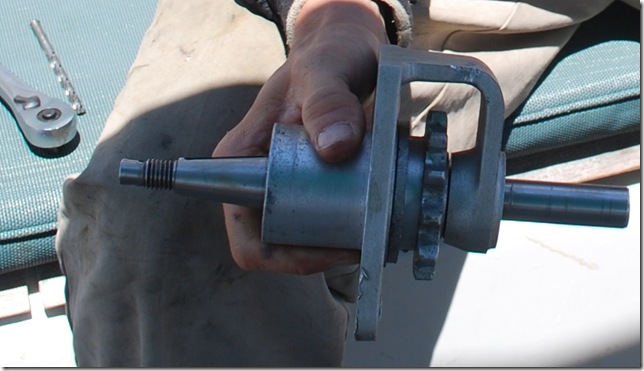 Completed steering assembly ready for installation after two long days of work
Completed steering assembly ready for installation after two long days of work
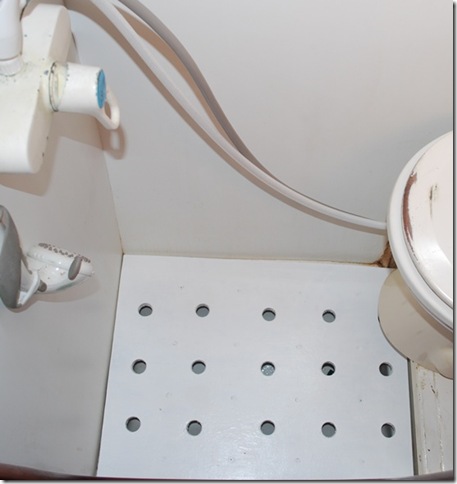 Don’t you think it makes the head look oh so roomy?
Don’t you think it makes the head look oh so roomy?
The bad news on the repair front is that when I started to repair the damage to the trampoline fittings, I noticed that things are quite a bit more serious than I thought. Most of the 6 mm stainless bolts were sheared off when our hull-to-deck joint worked loose on the inboard side of the starboard trampoline. Production boats like ours are built using a hull mold and deck mold. Once the interior of the boat is built up inside the hull, the large deck piece is fitted over it like a clam shell, and the two are bonded together around the edge. This is obviously a pretty critical structural part of the boat, and like most parts of our boat, it’s generally pretty strong. The exception seems to be this area of the bow, where there was some sort of bonding material between the hull and deck that has deteriorated and disappeared, and inside there’s only a layer or two of fiberglass that has also broken away. Pushing the boat too hard on the way from Tonga didn’t help things either. Luckily, there’s a boat builder directly across from us on the other side of the river, and we had a nice chat with the guy who runs it. He should be over on Monday to have a look and will be able to make the necessary repairs. It will probably be a bit pricey, especially since they can only haul out catamarans by renting a crane or using the railway, but it sounds like they do good work, and their labor rate is pretty reasonable (just over $35 US/hr) for this type of work. It’s another repair that will have to wait until after the holidays, so it should be a busy summer.
Martin’s been a lot of fun. At some point we discovered that we both love playing basketball, and he actually found a league here in Tauranga. They’re now between seasons, so we’ve had to settle for shooting around a bit, but tomorrow we get to play in a scrimmage, and we’ve gotten some pretty good exercise as well. He’s a great shooter, and is a physical education teacher in back home in Austria, so his fundamentals are pretty good as well. Anyone who’s actually been coached can pretty much run circles around me, but given my height and age advantage I’m able to stay competitive.
The more we explore, the happier we are that we’re in Tauranga. In addition to the nearby marine and industrial shops, there are two nice restaurant/nightlife/shopping districts. The one at Maunganui is a major vacation spot for Kiwis, with beach as far as you can see in both directions and plenty of wind for kite and windsurfing. Today we climbed “The Mount” and enjoyed the great views up and down the Bay of Plenty. In true Kiwi style, the lower portion of the mount is actively used for sheep grazing, which makes for some nice scenic hillsides with no lawn mowing bills to pay. The weather does take a bit of getting used to. There’s local saying that goes something like “You get all four seasons in one day,” and it’s true. A local told us yesterday that summer weather doesn’t really get going here until January, which is sort of good news. The sun here is pretty intense, so if it’s out it feels warm even if the temperature is fairly cool and there’s a strong wind blowing. If the sun goes behind the clouds though, it seems to get 10 degrees cooler almost instantly and as soon as the sun sets it’s cold.
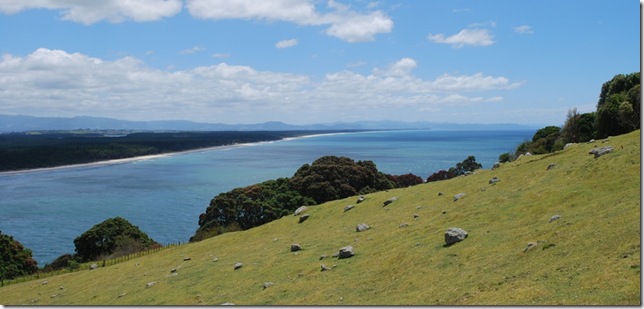 Looking north over the Bay of Plenty from the Mount hillside
Looking north over the Bay of Plenty from the Mount hillside
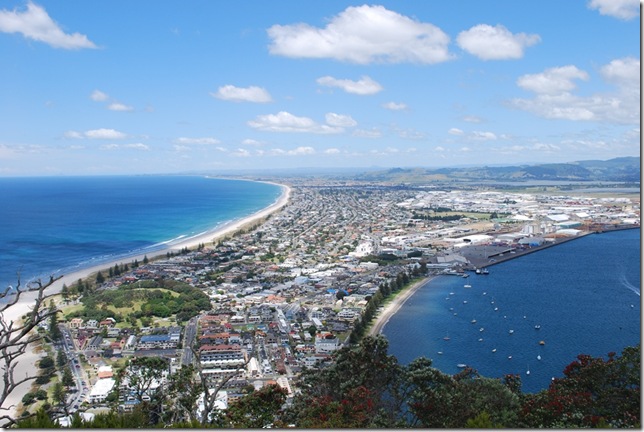 Looking back south over the tourist area and town of Mt. Maunganui
Looking back south over the tourist area and town of Mt. Maunganui
We still haven’t adjusted to first-world fashion prices, and life of the boat can be hard on clothes anyway, so we stopped off at the Red Cross thrift store on the way home from our hike and found some nice bargains. The store had a pretty funny sign in the window advertising newly-arrived Australian fashions. It’s definitely the only time I’ve seen a charity thrift store advertising their fashionable merchandise, and the clothing seemed about the same as in the US. When we checked out, I noticed that the cruise ship schedule for the year was posted behind the counter. I had to ask. It’s really hard to imagine people out on a cruise ship vacation getting excited about the Red Cross thrift store (“See, dear, right here on the map, the Red Cross thrift store is within walking distance of the where the ship is docking in Tauranga. Isn’t that great?”) It turns out that some of the vacationers do wander in but there is apparently quite a rush on cruise ship days from the Philipino crews who are either purchasing clothes for women and children back home or freezing in the cooler New Zealand climate and need something warm to wear.
Here are answers to a couple of navigation questions from Margo. We’ve had several people ask about this, and although there can be a lot to watch out for, navigating isn’t nearly the challenge it used to be.
Q: Could you write about navigation for those of us who are nautically challenged? Like how does it work at night and what is "along the rhumb line? Is it all high tech gadgets or do you still use the stars?
A: The short answer is that thanks to GPS and modern electronics, most of the time things are at least as simple as using an in-car GPS unit to navigate your way through an unfamiliar town on vacation. Of course we’re only travelling about 5 mph, so things happen a bit slower.
The rhumb line is just a nautical term for the straight-line course between two points – draw a straight line between your point of departure and your destination on a typical map, and that’s the rhumb line. On land, you would use the phrase “as the crow flies” to mean the same thing. The shortest distance between two points on the earth is actually called the great circle route, and it takes into account the fact that the earth is round. But, for shorter passages, the rhumb line is close enough and it’s used as the shortest path to your destination.
Navigation is basically the job of knowing where you’re at and setting your course so that you’re travelling in the direction you intend to. Near land, where there are markers and numerous reference points, it’s called piloting. Offshore navigation involves finding your way when you can’t see anything but sky and water. Just 25 years ago, the offshore sailor’s day revolved around taking sextant sights at various points during the day, and anyone who wanted to sail across an ocean had to trust their life to their celestial navigation capabilities. Navigating successfully without a GPS is a pretty impressive task that requires a number of skills, a lot of work, and some luck in terms of having a good enough view of celestial bodies to regularly get an accurate position fix.
We have several ways to navigate, so here’s a quick rundown…
1. Most of the time we navigate using our Raymarine C70 chartplotter. The charplotter is basically a small, waterproof, specialized computer, with a 7 inch screen that is connected to a GPS and is installed outside at the helm station. We plug in a Flash card with marine charts (like plugging in a USB thumb drive into a PC) and then our current position is displayed in the form of a little boat icon on top of the chart background. Charts are basically maps for sailors. They contain detailed information about a number of things, including water depths, locations of hazards like rocks, shoals, and wrecks, strong currents, and “aids to mariners” or marker and buoys that are placed near land to help you identify where you’re at and control the movement of marine traffic. Using the GPS, the chartplotter is able to tell us what our true speed and course over the ground are. This is different from the speed and heading provided by our knotmeter (device that measures out speed trough the water / boat speedometer) and compass heading because of local magnetic variation, leeway (wind pushing us sideways), and current, which could be pushing us in any given direction. Using the chartplotter is pretty straightforward and even someone who is unfamiliar with boating can get the basic hang of it pretty quickly. It’s pretty much like the GPS units used in cars except that it’s waterproof, the charts are expensive, and it also provides critical heading and speed information generated based on GPS.
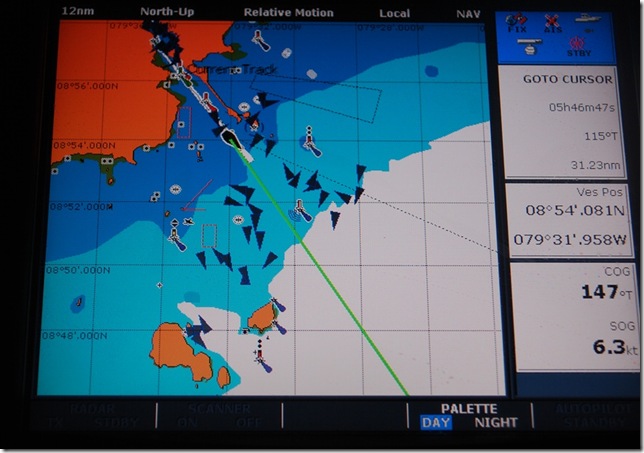 The modern navigatorL our chartplotter screen as we were leaving Balboa, Panama. The large box on the left shows our location on the chart, zoomed out to a fairly large scale. The green line is where we’re headed (in nautical terms, our Course Over Ground, which is different from our heading). The dark triangles come from our AIS system and represent other boats — there are a lot of ships near the canal entrance. On the right side, the top box tell us the distance, bearing, and time (at our current speed) to our destination. The middle box is our current latitude and longitude. The bottom box provides course and speed over the ground.
The modern navigatorL our chartplotter screen as we were leaving Balboa, Panama. The large box on the left shows our location on the chart, zoomed out to a fairly large scale. The green line is where we’re headed (in nautical terms, our Course Over Ground, which is different from our heading). The dark triangles come from our AIS system and represent other boats — there are a lot of ships near the canal entrance. On the right side, the top box tell us the distance, bearing, and time (at our current speed) to our destination. The middle box is our current latitude and longitude. The bottom box provides course and speed over the ground.
2. Murphy’s law seems to work overtime at sea, so we have some sort of redundancy plan for nearly every piece of gear on the boat. If we lose electricity or some part of the chartplotter system fails, we have a number of backups. The first and most reliable backup is paper charts of the area we’re sailing in combined with a handheld, battery-powered GPS to pinpoint our position. We use half-size black and white charts for backup due to the low cost and have three inexpensive Garmin eTrex handheld GPS units with plenty of spare batteries on board for finding our position without electricity on the boat.
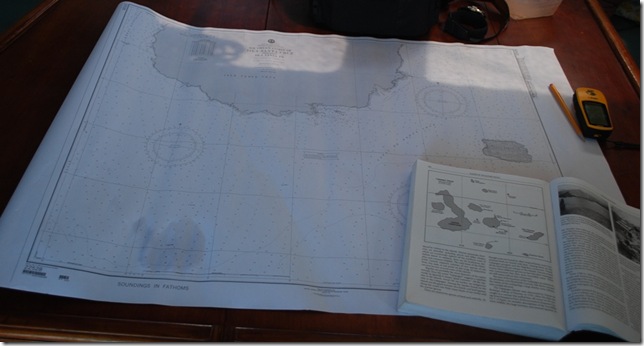 As we neared Puerto Ayora in the Galapagos, we pulled out the paper chart, our cruising guide, and one of our handheld GPS units (yellow Garmin eTrex on the right).
As we neared Puerto Ayora in the Galapagos, we pulled out the paper chart, our cruising guide, and one of our handheld GPS units (yellow Garmin eTrex on the right).
3. We can also use the handheld GPS units with our laptops to locate our position on computer-based charts. This can be pretty nice, especially since have computer charts for most all of the world. Because one brand of software that includes this capability along with world-wide charts has been pirated and passed freely among sailors for several years (at this point, we haven’t met anyone who doesn’t have a copy), it is the primary navigation source for more than a few people, but it’s also dependent upon electricity and a laptop functioning.
4. We do have a sextant and all the necessary almanacs, sight reduction tables, etc. on-board to perform celestial navigation using the sun, moon, and stars (we also have a battery-powered shortwave radio to pick up the time signals needed to keep our watches accurate). I’ve practiced noon sights (getting a good latitude and rough longitude reading at noon), but so far haven’t moved on to the more complex sights.
5. There are some other emergency-type navigation techniques that are good to be aware of, but are pretty unlikely to come into use. One of my favorites was the one used by the inexperienced 19-year old solo circumnavigator Tania Aebi before she finally figured out that her sextant was warped – she just sailed in the direction she needed to go and then radioed to passing ships to verify her location. Another funny rumored method that I was told about was practiced by some Russian sailors who reportedly sailed from southern California to Hawaii by following the passenger jets overhead.
Offshore, day and night navigation are basically the same when you’re using a GPS. Because we’re essentially always in unfamiliar places, we almost always make landfall during the daylight, even if it means we have to anchor off, drift, or slow the boat down to avoid reaching land in the dark. Charts and GPS are great, but when you’re close to land and reefs, there’s no substitute for a keeping a sharp watch.
Most of our time this last week has been spent working on the boat. A few of the items on our to-do list are a result of heavy use of the boat over the last 9 months, but most are improvements that we have always wanted to make but didn’t have time. For example, Dallas just replaced our old, worn-out lifelines, the wire ropes that encircle the boat and prevent man-overboard. Being a catamaran, we have more than 50 meters of lifelines in 10 different pieces. Instead of going with the swedged fittings at the ends, he created his own using thimbles and Nicopress-style crimps. One end of each lifeline was shackled, and the other end lashed. Not only was this a cheaper option, but it should be easier to inspect the condition of the lines now. The others were covered in white coating and taped, and there was quite a bit of rust and cracking underneath. Now he is tackling the steering system, which is turning out to be a nasty job…
Lashed end of a new lifeline. Note the white jellyfish in the water. They’re everywhere!
Meanwhile I’ve been doing some deep cleaning and general maintenance of things like winches, cushion covers, and cabinetry. I’m not handy by any means but find that tasks are much easier the second time around. Of course I’m also cooking and taking advantage of the opportunity to get whatever my heart desires from the grocery store. I’m getting used to driving the car on the "wrong side" (as people who aren’t from here like to call it), but when I’m alone, I invariably approach the left side of the car only to find that there’s no steering wheel there. I told Dallas about this, and he one-upped me–he actually got in and sat down in the passenger’s seat the other day!
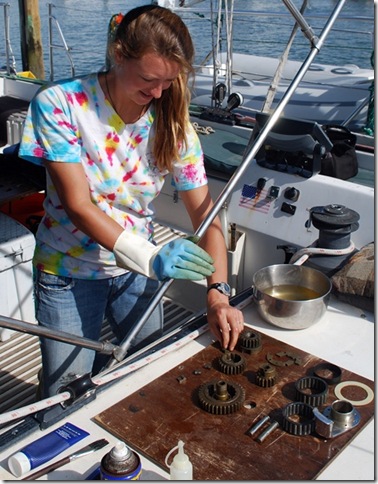 Cleaning and lubricating the parts of one of the six winches
Cleaning and lubricating the parts of one of the six winches
When we are not working, we are talking about work, so it feels like we are back in the U.S.! Actually, we do a lot of that, but we’ve also had some recreation such as jogging on the very nice beach here, finding some good local music at an Irish pub nearby, and hanging out with Martin from S/V Anima who arrived on Sunday.
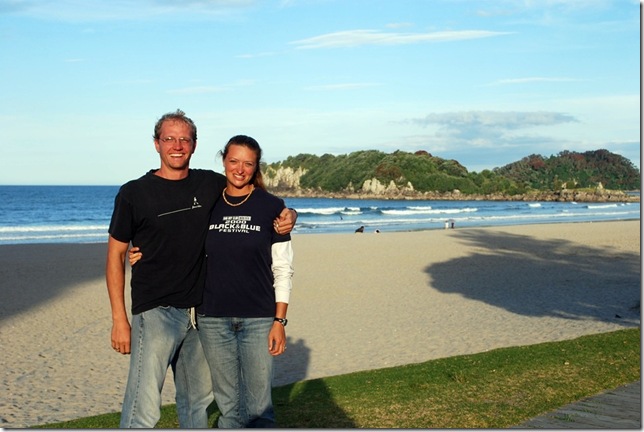 Checking out nearby Mount Maunganui
Checking out nearby Mount Maunganui
Tuesday night Martin fixed us an excellent Austrian meal of wiener schnitzel of pork (apparently it is Austrian law that restaurants must specify if they are not using the traditional veal), baked Camembert (for Dallas), and potatoes. Last night we had him over for a traditional (at least in my family) lasagna dinner followed by a brief (by our standards in the Pacific islands) jam session. It adds a lot to our quality of life to have to a friend around, particularly someone whose company we both enjoy.
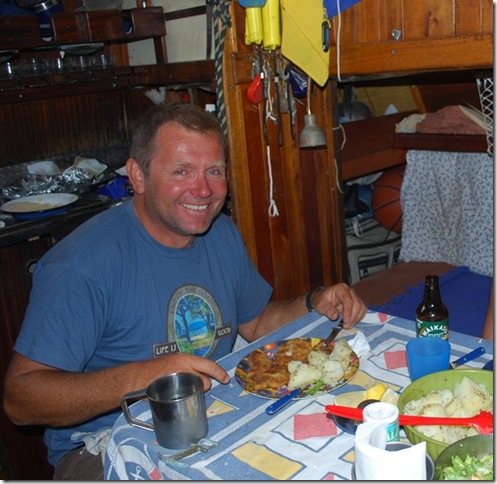 Das wiener schnitzel ist sehr gut!
Das wiener schnitzel ist sehr gut!
Dallas and Martin have several common interests as well. They have spent several mornings exploring the complex of marine stores that are part of the huge industrial park here. (Dallas says that they have everything from a mill for exotic timber to a foundry for metals.) They also found a local basketball league to join. Would you believe that while shooting around the other night, Dallas met an American who also went to KU! Perhaps we can join him in watching the #1 Kansas Jayhawks in the NCAA tournament in March if we can find a broadcast somewhere…
It feels like Christmas in July now that summer weather has set in. We’ve had a nice break from the rain, and the temperature has been hanging out around 75-80. I am looking forward to spending some more time on the beach this weekend, but I’ll be sure to take some sunscreen. The ozone layer is much more depleted here (up to 10% at some times of the year!) due to our proximity to the Antarctic ozone hole. It only takes a few minutes to get burned!
Well, sunny Tauranga has been anything but so far. It’s rained every day we’ve been here. We’ve heard some bad rumors that this is going to be a rainy summer due to El Nino, but hopefully they aren’t true, as we’re missing the sun.
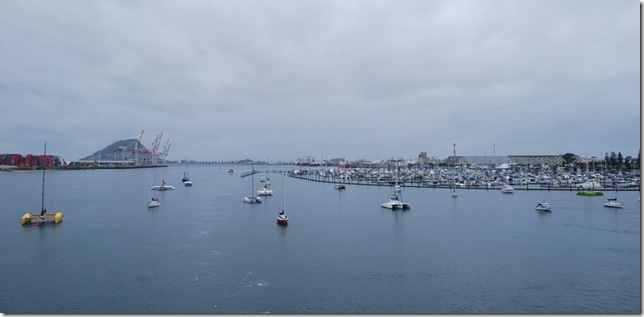 Another overcast day with our marina on the right and Mt. Manganui in the background
Another overcast day with our marina on the right and Mt. Manganui in the background
We’ve started making a few repairs, but have mostly been doing a little exploring, waiting for some sunshine, and trying to get caught up on e-mails. Lauren’s been doing a lot of cleaning and has started gluing together the various wooden strips of door and trim pieces that were knocked off during the last couple of months. We did finally eliminate one big item yesterday by buying a car (or caaa) as it’s called here. Using trademe.co.nz (NZ eBay equivalent) we bought a 1996 Honda Accord with about 120,000 miles on it for only $1400 US from a teacher who’s moving to England. The car was in Rotorua, so we had a nice cheap, afternoon bus ride over to Rotorua. We left from downtown Tauranga, which is a nice little shopping and nightlife area within walking distance. We’re still not used to shopping, especially for designer clothes at designer prices, so we mostly just walked around for a while after changing the US AMEX traveler’s checks from Bora Bora at the bank (FYI, traveler’s checks have a better exchange rate than cash).
We finally stopped in for a beer in one of the pubs and saw what must be one of the best game machines ever. It’s called Catch-A-Cray. Cray is short for crayfish, which is what lobsters are called here. The game is just like the ones in the US where you move a claw over a pile of stuffed toys and try to get it to grab one for your girlfriend, but in this case, instead of cute stuffed animals, there are lobsters in a tank of water. If you’re lucky enough to get one, it’s deposited into a chute at the corner of the tank and then drops out onto the floor! I’m not sure whether the local pub is setup to cook it for you or whether you just take it home in a to-go box. Before you decide that Kiwis are unrepentant sadists, I should note that there’s a sign on the game that says it was designed by someone who works closely with the SPCA and that there are features like double glass, special lights, etc. that render it stress-free for the crays. A couple of guys tried it while we were there and it works the same as in the US — you put your money in ($3 NZ), center and lower the claw, and then the claw starts to lift your cray of choice but won’t hold onto it. At least they don’t have to worry about skinny youngsters sticking their arms in and pulling out prizes for free.
The ride to Rotorua confirmed what we’d read and seen a bit of in the Bay of Islands — New Zealand is a largely agricultural country. There were lots of fields — kiwi fruit, a corn field, and lots of some sort of vine-type plant that I’m not familiar with. There were also lots of very tall, trimmed hedges separating land into various sized plots. Dairy cows and sheep were pretty common, but there were also a few beef cows, and a herd of deer. Rotorua itself is supposed to be the 2nd most popular tourist destination in NZ. Some call it Roto-Vegas, but we didn’t see anything in our brief stop that even remotely resembles Vegas. It does have natural hot springs, a big lake, lots of outdoor activities, and an ever-present sulfur stench (rotten eggs).
The car sale itself is pretty hassle-free here. You change ownership at the post office for $9 NZ. Both the buyer and seller fill out a form and they could also do it online up to a week after the sale. The plates are tied to the car and never have to be changed. There is a fairly reasonable licensing fee/sticker that can be purchased in 3, 6, or 12 month intervals. The big difference here is that the car has to have a fresh WoF (Warrant of Fitness) every 6 months, which is a bit more comprehensive than inspections back in the US (can include things like having to replace shocks or tires). Insurance is not mandatory, although we’ll price liability insurance just in case. The car looks pretty good for the price, although the seller was a little nervous when he handed me the keys, which seemed a bit odd. Turns out I’d forgotten to pay him and he wasn’t sure if he should say something or if I’d transferred the money to his bank account. Finally he said something which was great, because I’m absent-minded enough that I was about to drive off in the freshly transferred car with his $2k NZ in my pocket.
Driving back on the wrong side of the road with roundabouts and Friday evening traffic we haven’t seen let alone driven in for a long time was a bit of an adventure, but it went pretty well. We did have a bit of a shock when we stopped at the gas station (of course the fuel warning light was on when we pulled out of the driveway) and a fill-up cost $85 (about $US 4.5/gallon). The hardest part was just pulling out into busy traffic after having not done it since March. When you’re not used to it, cars seem like they’re going so fast that you’re wondering how people do it, but I guess they think the same thing about sailing hundreds of miles offshore.
The boat has to have a WoF as well from an electrician to be able to plug in to shore power, so we haven’t plugged in yet. We have a heavy 3000W 220V-to-110V converter that we’ve lugged all the way here, but so far the solar panels and wind generators have done pretty well. We got a little low on electricity last night after several calm, rainy days, but we actually had to cover the panels to keep the battery voltage down last week in Russell after several sunny days as we just don’t use that much electricity.
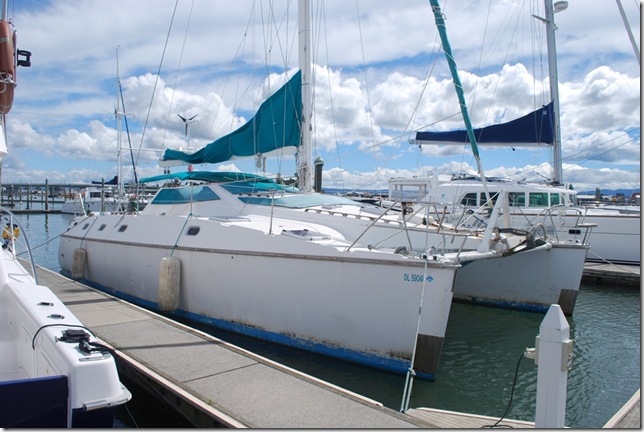 The staff is incredibly friendly, but being in a slip is still feels strange
The staff is incredibly friendly, but being in a slip is still feels strange


